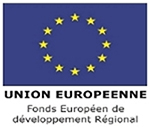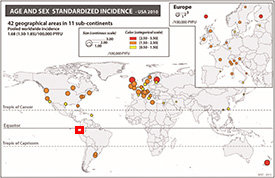Thèse soutenue de Daniells Andrea ERAZO
Amyotrophic Lateral Sclerosis in Latin America
The beam of evidence about the heterogeneity on ALS incidence, mortality and phenotype between human populations is based on different clues:
– A meta-analysis of ALS incidence (Marin et al. Int J Epid 2017), (considering data of about 13,150 ALS cases reported worldwide), based on population based studies with multiple sources for case ascertainment – gold standard methodology for descriptive epidemiology – showed that subcontinent was the main source of incidence heterogeneity. While standardized incidence of ALS appeared homogeneous in populations of European origin in Europe, North America and New Zealand (pooled ALS standardized incidence of 1.81 (95%CI 1.66-1.97)/ 100,000 person years of follow up (PYFU)), incidence in Eastern Asia (Japan, China) has been found significantly lower 0.83 (95%CI 0.42-1.24)/100 000 PYFU), as in South Asia (Iran, 0.73 (95%CI 0.58-0.89)/100 000 PYFU).
– A meta-analysis of ALS phenotypic and survival characteristics (Marin et al. Eur J Epid 2016) (considering data of about 12,700 ALS cases reported worldwide) highlighted the phenotypic heterogeneity of ALS at time of onset [age, sex ratio (SR), bulbar onset], age at diagnosis, occurrence of comorbidities in the first year after diagnosis, and outcome (survival). Subcontinent was also a major explanatory factor for the variability of the ALS phenotype. Some markers of ALS phenotype were homogeneously distributed in western countries (SR, mean age at onset/diagnosis) but their distributions in other subcontinents were remarkably different. Other markers presented variations in European subcontinents (familial ALS, bulbar onset) and in other continents. As a consequence, ALS outcome strongly varied, with a median survival time from onset ranging from 24 months (Northern Europe) to 48 months (Central Asia).
– Reports form mixed populations in the United Kingdom and the USA, constantly showed lower incidence and prevalence in non-Whites populations (Hispanics, Asian, African American) as compared with Whites (Rechtman et al. 2015). Also, mortality studies reported consistently that ALS mortality was lower among Hispanics and African American people as compared with White people. Lastly, a mortality study in Cuba found that ALS adjusted mortality rate was considerably lower in the mixed population: 0.55 (95%CI 0.40-0.72) than in whites (0.93/100,000 PYFU; 95%CI 0.83-1.03) and blacks (0.87/100,000 PYFU; 95%CI 0.62-1.17) (Zaldivar Neurology, 2009).
ALS is considered as a complex genetic disease caused by multiple susceptibility genes interacting with a variety of environmental risks. European populations share common ancestral origins and, depending on the degree of relatedness, are likely to share a variety of rare “at-risk” genes, combinations of which may increase susceptibility to disease. Conversely, admixed populations, containing a much wider variety and different combinations of at-risk alleles, might experience a lower overall risk of developing the disease.
At this stage, it is necessary to determine the variability of ALS incidence, mortality and phenotype in Hispanic populations (Latin America and more specifically in Ecuador, including ethnically mixed and admixed populations) using homogeneous and standardized methodology. This will be done through different studies.
General objective: To describe ALS epidemiology, clinical characteristics and practices for diagnosis and management in Latin America
Specifics objectives:
Methods : Four different studies will be perform :
——————————————————————————————————————————————–
Mots clés : Amyotrophic Lateral Sclerosis, Latin America, Epidemiology, Clinical Characteristics and Frecuency of genetic mutations
Co-financement FEDER

Soutenue publiquement le 28 juin 2022
 Accéder à la fiche de thèse Unilim
Accéder à la fiche de thèse Unilim
 Accéder au manuscrit de la thèse
Accéder au manuscrit de la thèse
——————————————————————-

Daniells Andrea ERAZO
PhD
daniellsandrea7@gmail.com
Sous la direction de
Philippe COURATIER
PU-PH
Directeur de thèse
Jaime LUNA
MD, PhD
Co-directeur de thèse
——————————————————————-
 Articles –
Articles –  Colloques –
Colloques – Posters
Posters
——————————————————————-





